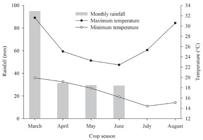ABSTRACT
Chickpea is the third most cultivated legume in the world. In Brazil, cropping of this legume is recent and definitions of fertilizer management techniques are scarce. In this study, the objective was to evaluate chickpea (BRS Aleppo) production and soil chemical attributes with and without phosphorus fertilization and leaf-applied molybdenum. A randomized block experimental design was used, with four replications. A 2 x 5 factorial arrangement was used to evaluate production, consisting of two molybdenum fertilization management practices (with and without molybdenum) and five application rates of P2O5 (0, 60, 120, 180, and 240 kg ha-1) in the form of single superphosphate. Soil sampling for evaluation of soil chemical attributes in the crop row and between rows was also considered. Molybdenum fertilization brought about greater stem and aboveground dry matter. Phosphorus fertilization increased stem, leaf, and seed yield, yielding a maximum of 2.83 t ha-1 seed at the rate of 200 kg ha-1 P2O5. However, maximum agronomic efficiency (8.30) was observed with the addition of 150 kg ha-1 P. Soil in the crop row attained higher concentrations of P, K, H+Al, and P-rem and reduction in pH, Ca concentration, SB, T, and V compared to between rows. Phosphorus rates reduced soil pH and increased T and the P concentrations, though only in the plant row. Between the rows, no changes were observed in soil chemical attributes, indicating low mobility of P and the acidification capacity of superphosphate in alkaline soils.
Index terms:
Cicer arietinum L.; single superphosphate; seed yield

 Thumbnail
Thumbnail
 Thumbnail
Thumbnail
 Thumbnail
Thumbnail


